First Descent: Thoughts, Feelings, and Memories from My Dive in Alvin
Written by: Lauren Dykman
There’s a sense of finality as Alvin Pilot Bruce Strickrott closes and secures the hatch: for the next nine hours, we will have nothing but what we carry sealed inside. Looking out the viewports, I see the ocean and rising sun beyond the fantail, and the chase boat floating in wait to see us off. So many people are standing by to wave as we descend, and this process has relied on intricate coordination among all of them. For months, I have wondered how I would feel when the hatch finally closed. “What would be my reaction? Would I panic?”
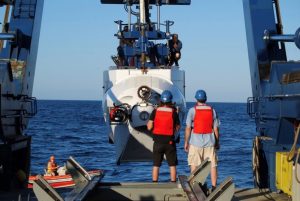
Pilot-in-training (PIT) Nick Osadcia and Pilot Phil Forte get a thumbs up from PIT Rick Sanger atop the sub. Photo: Lauren Dykman.
Back in some drawer in my childhood home, under piles of used sketch pads, there’s a sheet of paper on which 12-year-old me outlined lifetime goals. Become a biologist, learn SCUBA, get a PhD (on that voyage now). Then down there on the list: dive in Alvin.
When the moment arrives, there’s no fear, only joy. The swaying of the sub indicates that we are being lifted off the deck, a process I’ve already watched many times from outside. There are swimmers crouched atop the sub waiting to disconnect us from the lift line. Once we’re in the water, I’ll see them swim past as they conduct final safety checks. Now, I’m waiting for the last glimpse of horizon before turquoise water dominates the viewport.
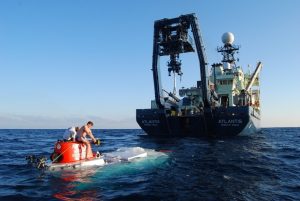
Swimmers do a final check at the surface before Alvin gets the go-ahead to descend. Photo: Lauren Dykman
How did we as scientists and, in my case, a new diver prepare for the voyage? First, there is a detailed dive plan, written by the chief scientist and passed around to involved parties for editing. It is a checklist of specific objectives, supplemented with maps and photos of items we need to collect (it’s not always easy to tell what you’re looking for down there). Each dive plan ends with the critical final instruction: Come Home. Every night, a post-dive/pre-dive meeting is held after dinner in the ship’s library. We learn that on our Christmas Day dive, Pilot Bruce Strickrott, Texas A&M post-doc Amanda Achberger, and I will complete a diverse array of tasks from scientific to exploratory. Scientists have been studying this hydrothermal vent field on the East Pacific Rise for decades to understand how life on the seafloor changes and recovers after volcanic eruptions. Our first mission is to take samples and pick up experiments that have been deployed on the seafloor as part of long-term studies. Finally, (the icing on the cake) we are to explore a new site that has never been seen before. The prior night, autonomous mapping vehicle Sentry picked up a blip on the seafloor – a large mound, dubbed “Mystery Mound,” that seemed to be around 10 meters tall, with a few spires around it. We are to traverse nearly a kilometer of seafloor to survey, photograph, and mark it.
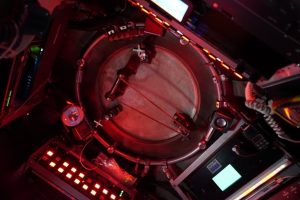
The hatch is secured by three hand-tightened bolts. Once we’re underwater, pressure will seal it further. Photo: Stace Beaulieu.
Before diving in Alvin, everyone must complete an in-sphere orientation. On the night before our dive, Amanda and I are brought into the sphere, in my case for the first time, for training led by Pilot Drew Bewley. Shoes must be removed and left outside the hatch. It is important not to touch the sealing face of the hatch when climbing down the ladder, as this is what keeps the water out. Drew sits facing backwards in the pilot’s chair and explains the safety systems. These are the switches to drop weights, here’s the instruction binder for returning to the surface if the pilot is incapacitated, there are your oxygen masks. Every item on the sub’s exterior that could become entangled – the science basket, the manipulator arms, the thrusters – can be jettisoned by multiple redundant switches. Every system vital to operation is hard-wired, not controlled by computer. There’s enough oxygen to last us three days. Amanda has done this before and doesn’t have much to ask, but I’m full of questions: What does this button do? How do we control the cameras? Where are the rations stored? That night, we are to pack a pillow case with data sheets, clipboard, and warm clothing (it will get chilly inside once we’re down deep) and leave it in a bin above the Alvin bay. Our supplies will be waiting for us in the sub in the morning, so all we will need to bring is ourselves.
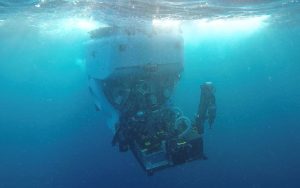
Beginning descent at the start of our dive. Photo: Ronnie Whims
We get the go-ahead to descend and begin to sink at a rate of 40 meters per minute. This will put us on the seafloor 2,500 meters below in slightly over an hour. I’ve learned about “marine snow” in my education as an oceanographer, delicate bundles of organic matter sinking down from the photic zone. I now marvel watching their fluffy silhouettes fly past my view in the backlit water column as a testament to our downward progress. The fading blues and greens are like nothing I’ve ever seen before. But sunlight is gone within ten minutes. We are now in the embrace of the dark ocean, the largest biosphere on the planet – and we’ll continue descent in this dark for another hour. Five more Empire State Buildings down.
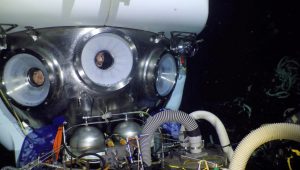
Pilot Bruce Strickrott and I observe V-vent through the viewport. Photo: Imagery © Woods Hole Oceanographic Institution (WHOI) 2020
Bruce swivels about in the pilot’s seat throughout descent; reaching up, flipping a switch, checking a gauge, fiddling with the oxygen tanks, adjusting the lights. I can only guess what’s going on. At intervals, Bruce calls up our depth to Top Lab, the command center aboard the Atlantis where the team monitors Alvin’s progress. Occasionally, chatter comes down to us. Unlike an ROV, we are not tethered to the ship. This allows more range for exploration, but makes navigation and communication particularly critical to safety and success. As the temperature outside cools, condensation forms on the metal walls of the sphere. This is important for a new diver to know, so rather than panicking as water trickles down the viewport, we calmly grab a wipe and dry the (fresh) water away. Bruce has on a playlist of music and descent begins to feel like a road trip, except that outside the small window is a flashing light show of bioluminescent creatures disturbed by our wake. This surreal mingling of the ordinary with the extraordinary will continue throughout the day.
After an hour, we’re approaching 2,500 meters, more than a mile and a half down. External pressure: 3,600 pounds per square inch. Bruce instructs us to watch out for the bottom. In an instant, the abyss below resolves into a field of contorted basaltic lava flows. Black, shiny lava pillows extend to the reach of our floodlights, much like photos I’ve seen of Hawai’i Volcanoes National Park. We touchdown and raise a cloud of sediment. Surrounding us, going about their daily lives, are the animals I’ve seen in documentaries. Glistening worms with glassy paddles slither through the water. A large, spikey sea star with long suckers has been flipped sideways by our wake and is laboriously righting itself. A long-legged shrimp swims past view. An octopus steals a wary glance from a crevasse in the distance.
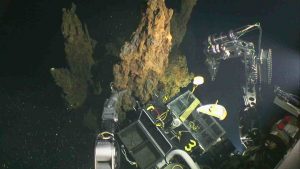
Collecting sulfide samples into a “biobox” using the manipulator arm. Photo: Imagery © Woods Hole Oceanographic Institution (WHOI) 2020
We motor towards the rift valley between two oceanic plates, where the hydrothermal vent fields are. This is a place I’ve studied for two years, but never yet seen. We descend over the lip, and the ground is suddenly strewn with large mussels, white tube worms, ghostly fish slithering like eels, and skittering crabs. Hot water shimmers from 30-foot-tall spires. Bruce navigates between these obstacles with dexterity. One of tasks of scientist observers is to keep watch out the side viewports and warn the pilot if we are drawing near hidden spires or hot water, as these could damage parts of the sub.
After focused navigation in tight spaces, we set to work on science objectives. We walk Bruce through the checklist, and he deftly positions the vehicle and uses the manipulator arms to take temperature readings, and place a trap that I hope will catch crabs and fish for my thesis research. He instructs us not to move during particularly delicate operations, as shifting weight can rock the sub. Later, as Amanda instructs Bruce through her science objectives of collecting sulfide samples, I sneak in eating my lunch (the traditional peanut butter and honey sandwich), thinking, “this is the weirdest thing ever: ape-descendants in a sphere in the deep sea, snatching rocks that have never seen daylight while eating white-bread sandwiches.”
We then transit across sheets of contorted lava to the new site, Mystery Mound. It rises out of the abyss, 10 meters tall and surrounded by a field of spires. We survey it by crisscrossing the site and taking photos. At this point, we all have to pee pretty badly. In the galley of the Atlantis, there’s a wood-carved sign that says “PB4UGO,” which also serves as a reminder not to drink too much coffee at breakfast. There’s always the question “did you pee in Alvin?” Yes, I did pee in Alvin. There are red bottles in a hatch in the floor, and funnel adaptors for women. You fill your bottle, then empty and clean it that night back on the ship. We all three park to pee right atop the new Mystery Mound, which is poetically reminiscent of “marking the territory.” We then poured a round of coffee to further test our bladder fortitude. We also place an actual marker, a positively-buoyant circular disk numbered 16, at the summit.
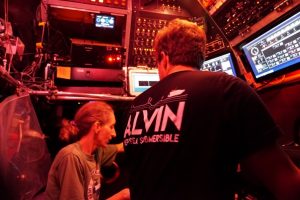
The inside of Alvin is more spacious than it seems. In this photo, “Port” scientist Stace Beaulieu walks through the science objectives on her clipboard with Pilot Drew Bewley. Photo: Imagery © Woods Hole Oceanographic Institution (WHOI) 2020
All too soon, it is time to ascend. Once we drop weights, the seafloor quickly dissolves from view. Unlike with SCUBA, there’s no need for Alvin divers to decompress on ascent. That’s because pressure in the sphere does not change throughout the dive. It actually becomes slightly lower than atmospheric pressure at sea level due to the cooling temperature, and because the pilots reduce oxygen content from 21% to 19% to decrease fire risk. Therefore, working inside the sphere is like being around 1,500 feet above sea level.
The nine-hour dive really flew by. Before I know it, we are being lowered onto the deck of the Atlantis. The hatch opens with a gust of warm air and a ladder is lowered down. Being the newbie, I’m beckoned to be the first diver out. With cramped legs, I ascend into tropical daylight. There is the crowd of friends waiting below, clapping and cheering. New divers are presented an amulet made from scraps on the ship, and ceremonially splashed with a full bucket of ice water. No rite of passage has ever meant more to me.
What’s humbling is working with the people. This incredibly technical dance is accomplished by everyone aboard the ship doing their jobs with competence and care. The RV Atlantis Crew and DSV Alvin Ops Team work long hours and perform painstaking and risky work to support the science projects of people they have only just met. When science objectives aren’t met, the Alvin team takes it to heart – after one of our dives was aborted for a leak in an electrical box, the team worked late into the night and had the sub back in the water on schedule the following morning. They are explorers who, like us scientists, want to know what is down there and what remains beyond the narrow range of the sub’s lights. In turn, scientists write grants and provide the incentive to keep Alvin at work.
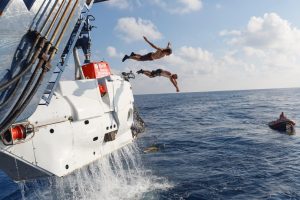
Swimmers dive off Alvin as it is hoisted from the water, often waiting for maximum height. Extra points for style! Photo: Jason Sylvan.
Although remotely-operated vehicles are also useful tools for exploring the deep sea, my dive impressed upon me the importance of continuing to visit in person. Bringing observers down, placing them face-to-face with the fragility of an untouched frontier, instills an immediate understanding of how much we have to lose. With deep-sea mining already undergoing trials, it is critical that we continue to explore, discover, and test hypotheses. We know so little about our own world. We have mapped much more of the surface of Mars in high resolution than our own seafloor, most deep-sea species have not been described, and we know even less about species ranges, abundances, and abilities to cope with disturbance. Each dive provides just a fragment of insight, every collection a tiny point-source view into the forces governing the dark majority of our planet. But science is a patient process. Over decades, persistent exploration has built up a robust body of knowledge. Writers, communicators, and artists have also completed Alvin dives to translate the wonders of the deep sea into a visceral, relatable medium. It is the human factor, the emotional connection of seeing the life there firsthand, and collaboration between people with different skills and experience, that is crucial for promoting stewardship of these remote marine realms.
For a 360° tour inside Alvin, see this link!